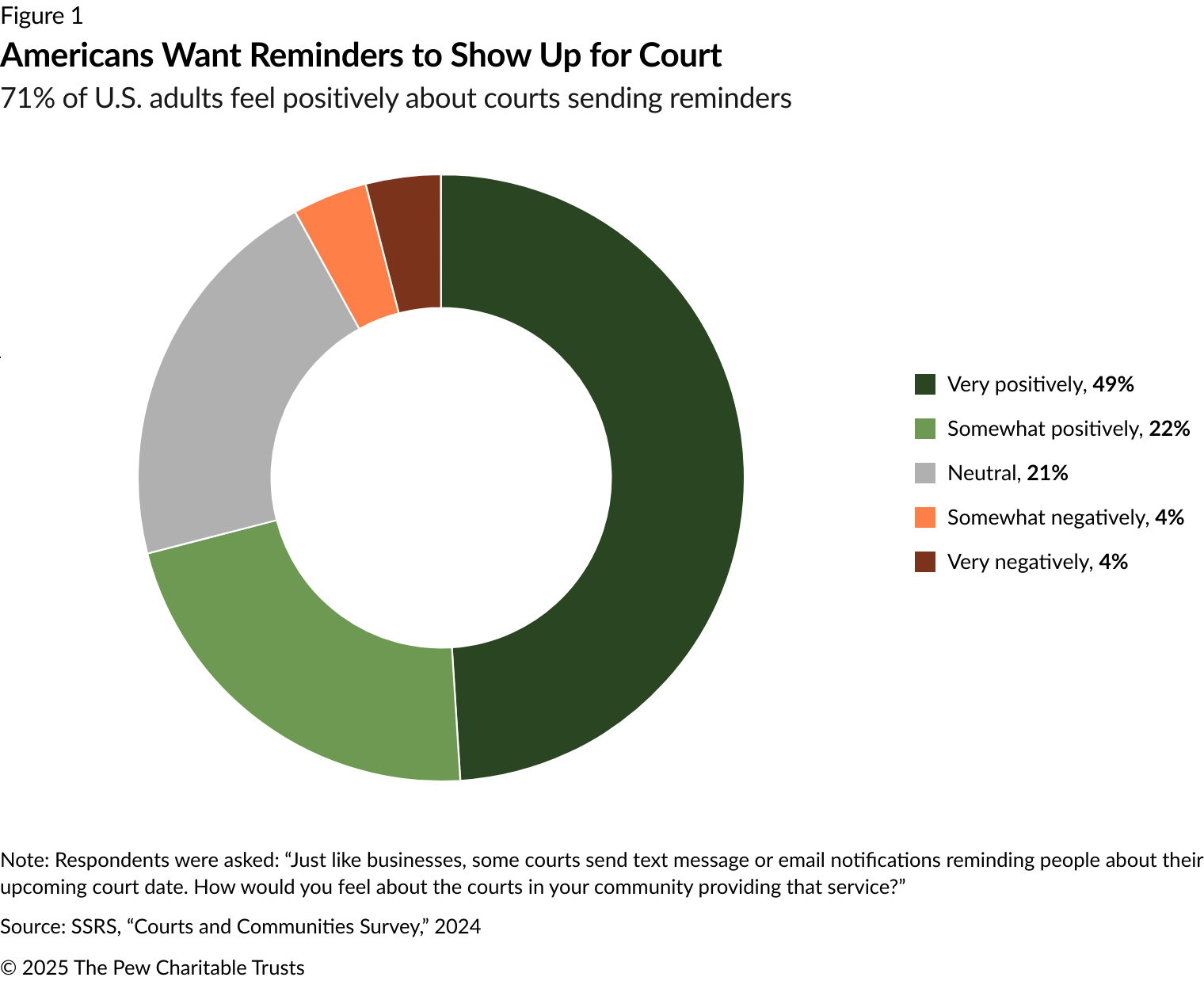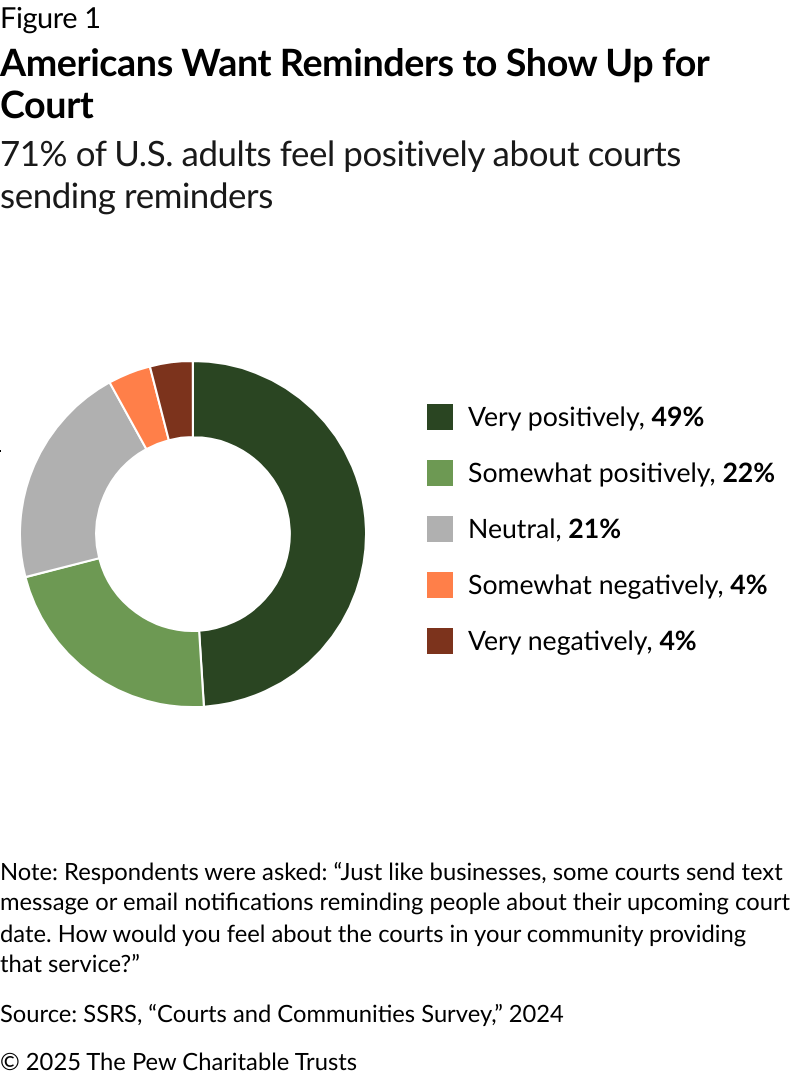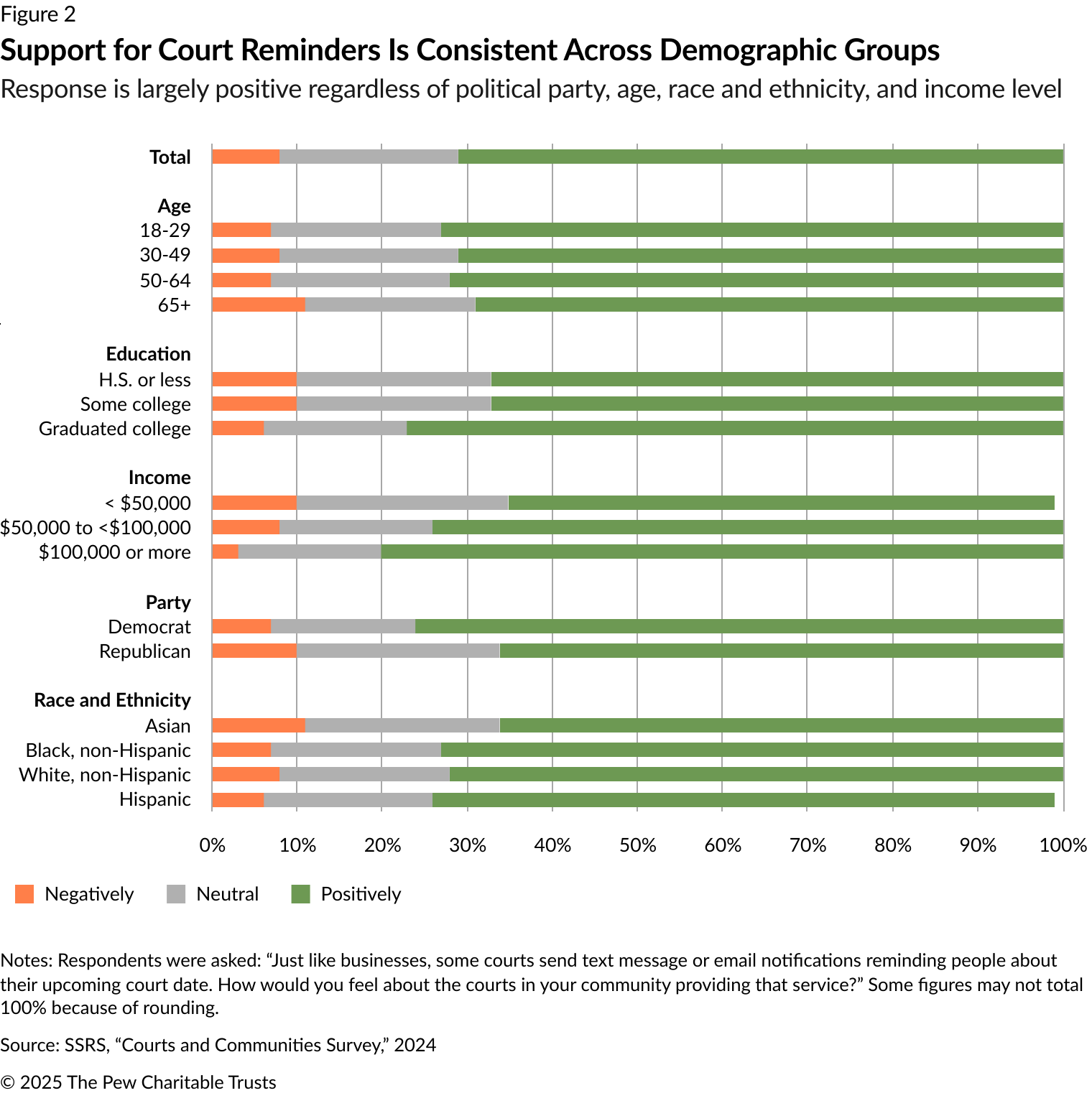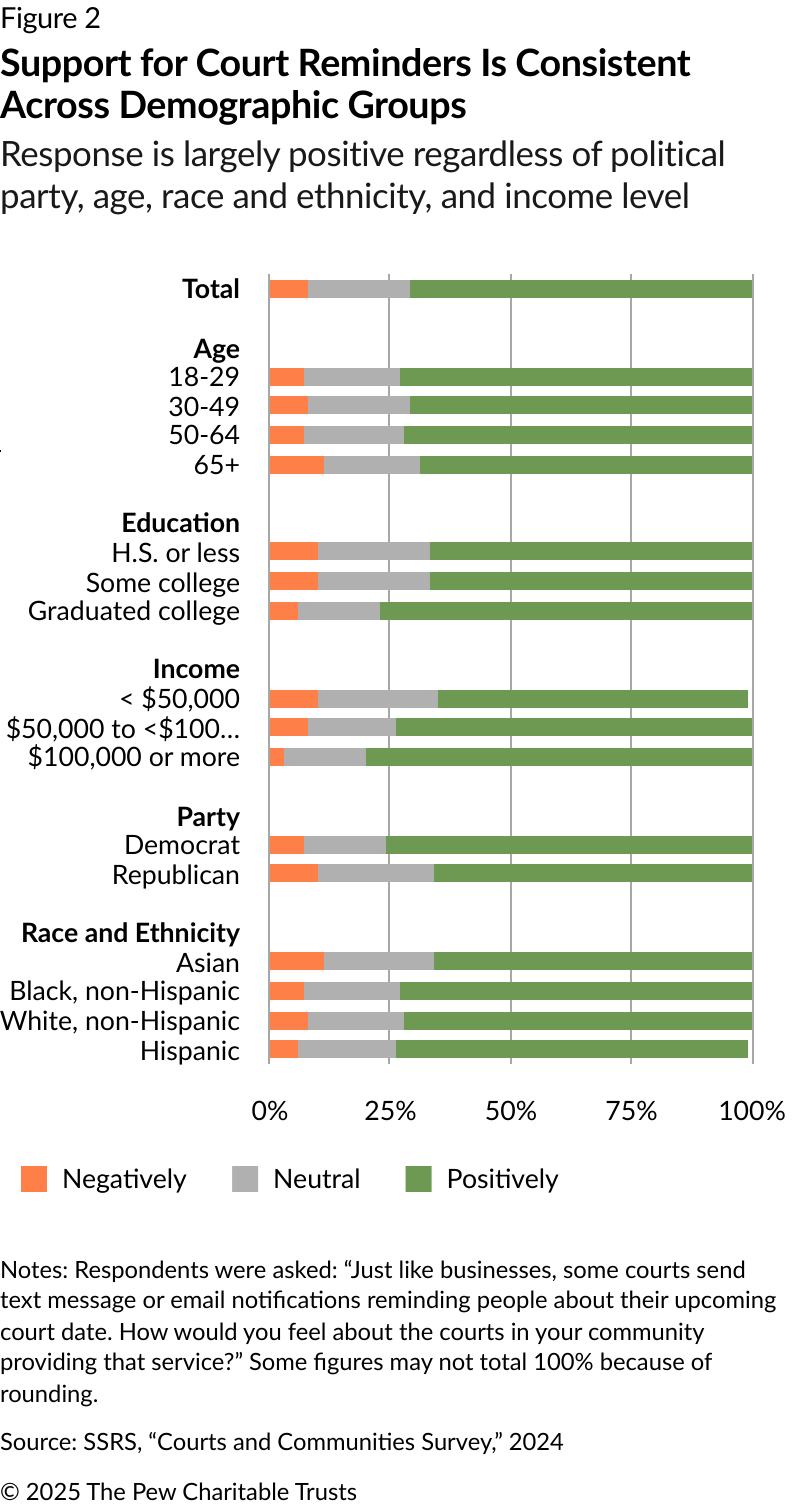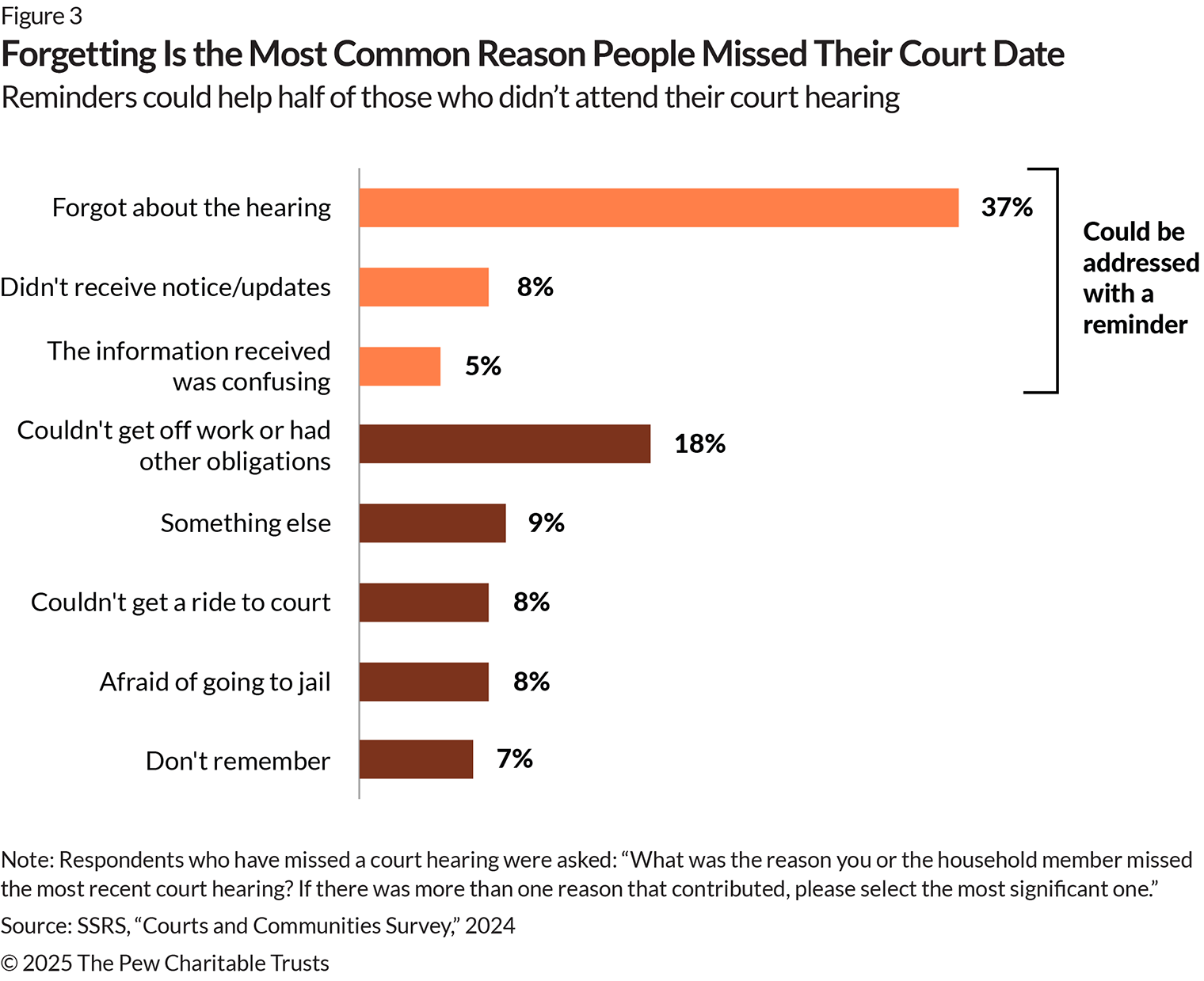Court Reminders Have Broad Bipartisan Support
New national poll suggests strong endorsement for a simple tool that helps the public show up for court
Overview
Each year, state courts handle about 66 million cases1, many of which require people to go to court for at least one hearing, and often several. Although most people show up for court, no-shows in even a small percentage of cases add up to millions of missed hearings that slow court operations and can result in severe consequences for individuals, including financial penalties, driver’s license suspension, and even jail time.
But courts have a proven way to reduce these missed hearings. Research suggests that sending someone a reminder about an upcoming court hearing via text, email, or phone call—just as a dentist’s office or hair salon might do before an appointment—is a consistently effective way to reduce missed court hearings.2
New research from The Pew Charitable Trusts sheds light on how people in the U.S. feel about court reminders and why people miss court. The results suggest that court reminders aren’t only effective—they’re popular, too.
A bipartisan majority of U.S. adults support court reminders
According to a national poll released by The Pew Charitable Trusts in August 2025, more than 7 in 10 U.S. adults (71%) have positive feelings about courts providing court date reminders to people in advance of their hearings. The poll suggests that about 1 in 5 U.S. adults (21%) are neutral about reminders, and just 8% have a negative response.
Support is broad, with adults across political parties, age groups, racial and ethnic backgrounds, income levels, and education levels strongly approving court reminders.
Reminders address common reasons people miss court
Pew’s national poll asked respondents about whether they or a household member had ever had a case in court for a civil, family, traffic, or criminal matter. Of those who had, 19% said that either they or a household member had missed a court date associated with their case. This rate is consistent with other studies about defendants missing court, one of which found that other court participants, such as police officers and attorneys, missed at higher rates.3
When asked why they missed court, the most cited reason was that they had simply forgotten about the hearing—37% cited this as the main reason.
Some of the other reasons for missing court could also be addressed by receiving a reminder. For example, 8% of people who missed court said it was because they didn’t receive notice about their hearing in the first place, and 5% said they found the information too confusing. A simple text message reminder with the date, time, and location of someone’s court hearing might help with these issues. In fact, reminders could eliminate the main reason for missing court for at least half of all people who said they or a household member had missed a hearing.
Methodology
On behalf of The Pew Charitable Trusts, public opinion firm SSRS conducted a nationally representative online poll of 2,016 adults examining public attitudes toward state and local courts from Aug. 22, 2024 to Sept. 13, 2024. The data presented here focuses on experience and attitudes related to missed court appearances and the use of court date reminders. The margin of error based on the entire sample is 2.8 percentage points; for subgroups, the margin of error may be larger. For details about the methods, see the poll’s Methodology Report4, and to examine the comprehensive poll results, see “Experience With State Courts Highlights Areas for Improvement.”5
Endnotes
- “State Courts Play a Key Role in American Life,” The Pew Charitable Trusts, 2024, https://www.pew.org/en/research-and-analysis/issue-briefs/2024/10/state-courts-play-a-key-role-in-american-life.
- Samantha A. Zottola et al., “Court Date Reminders Reduce Court Nonappearance: A Meta-Analysis,” Criminology & Public Policy 22, no. 1 (2023): 97-123, https://onlinelibrary.wiley.com/doi/abs/10.1111/1745-9133.12610.
- Brian A. Reaves, “Felony Defendants in Large Urban Counties, 2009—Statistical Tables,” Bureau of Justice Statistics, 2013, https://bjs.ojp.gov/content/pub/pdf/fdluc09.pdf.University of North Carolina School of Government Criminal Justice Innovation Lab, “North Carolina Court Appearance Project,” 2022, https://cjil.sog.unc.edu/wp-content/uploads/sites/19452/2022/04/NC-Court-Appearance-Project-Report-4-22-22.pdf. Lindsay Graef et al., “System Failure to Appear in Court,” University of Pennsylvania Law Review 172, no. 1 (2024).
- Courts and Communities Survey Methodology Report, prepared for The Pew Charitable Trusts by SSRS, 2024, https://www.pew.org/-/ media/assets/2025/08/courts-and-communities-survey-methodology-report.pdf..
- “Experience With State Courts Highlights Areas for Improvement,” The Pew Charitable Trusts, 2005, https://www.pew.org/en/researchand-analysis/issue-briefs/2025/08/experience-with-state-courts-highlights-areas-for-improvement. SSRS, “Courts and Communities Survey” (survey, commissioned by The Pew Charitable Trusts, 2024).
